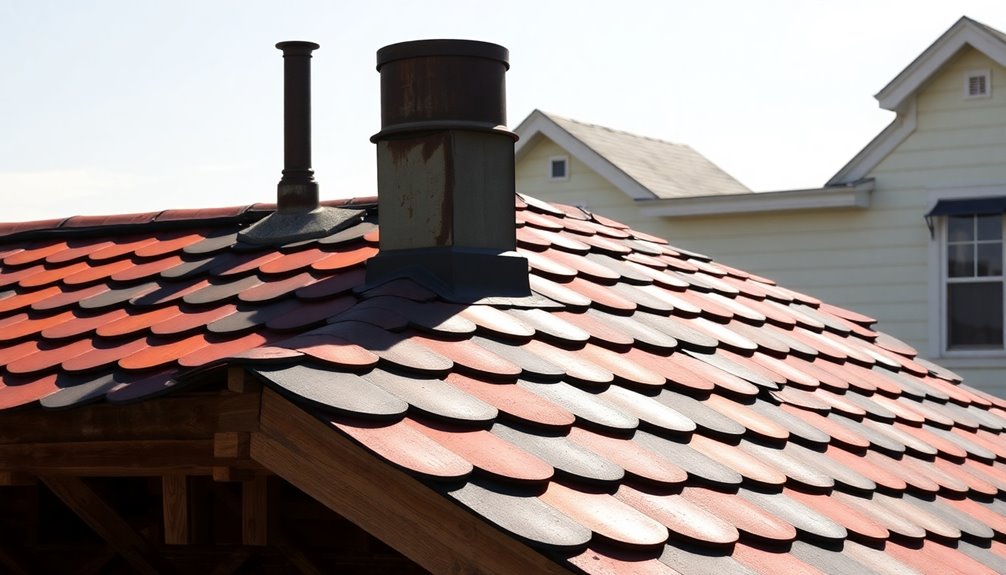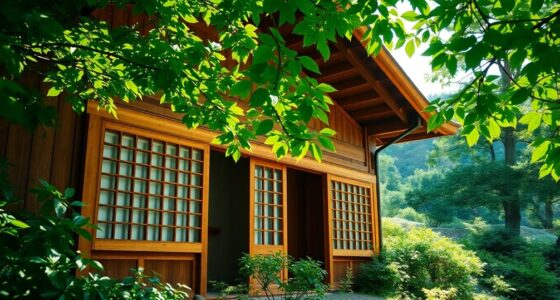In the 1950s, roofs were primarily made of asphalt shingles, metal, clay tiles, and cedar shakes, each offering unique benefits. Asphalt shingles were the go-to choice for homeowners due to their affordability and variety, while metal roofs became popular for their durability and sleek designs. In warmer regions, clay tiles thrived for their resilience against heat, and cedar shakes added a natural aesthetic to upscale homes. Roofs also reflected regional styles and architectural trends of the time. There's more to uncover about the materials and techniques that defined this era, so keep exploring!
Key Takeaways
- Asphalt shingles were the most popular roofing material due to their affordability, variety, and functionality for residential homes in the 1950s.
- Metal roofs, primarily aluminum and galvanized steel, gained traction for their durability and sleek design, especially in commercial and industrial settings.
- Clay tiles were favored in southern regions for their aesthetic appeal and ability to withstand heat and humidity, particularly in Mediterranean-style architecture.
- Cedar shakes and wood shingles were popular in upscale and Pacific Northwest homes, valued for their natural appearance and insulation properties.
- Slate roofing symbolized affluence in the Northeastern U.S., offering durability and elegance for traditional homes while asphalt shingles were also commonly used.
Overview of 1950s Roofing Materials
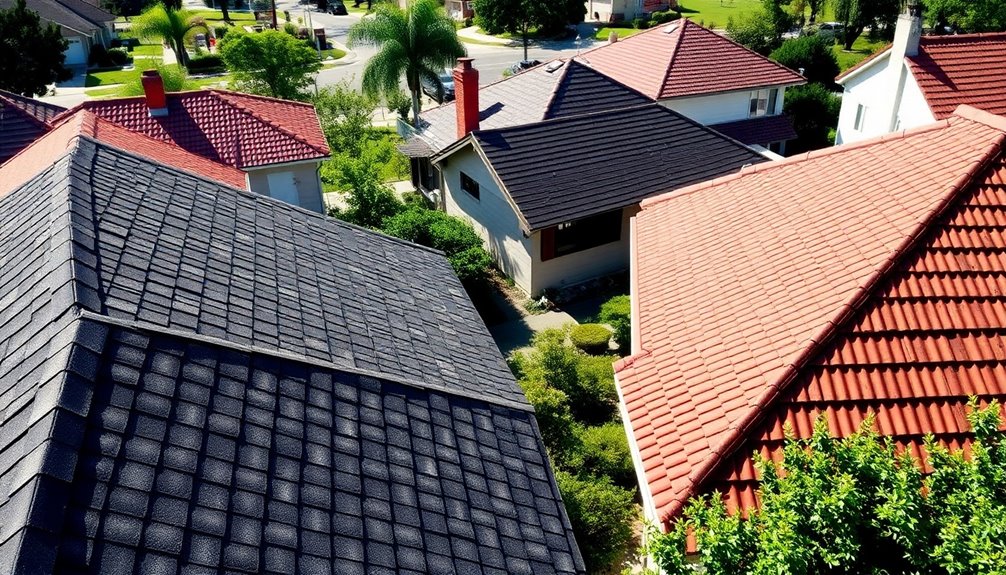
In the 1950s, as homeowners sought both style and practicality, asphalt shingles emerged as the go-to roofing material for residential construction. Their affordability, ease of installation, and variety of colors made them highly appealing.
Meanwhile, metal roofs, particularly aluminum and galvanized steel, gained traction in both residential and commercial construction for their durability and long lifespan.
In areas influenced by Mediterranean architecture, clay tiles offered aesthetic charm and fire resistance, though they weren't as popular in colder climates.
Cedar shakes and shingles also experienced a revival, providing a natural look and good insulation.
For commercial buildings, mineral-surfaced roll roofing became the standard choice for flat roofs, delivering effective protection against water infiltration.
Popular Choices and Trends
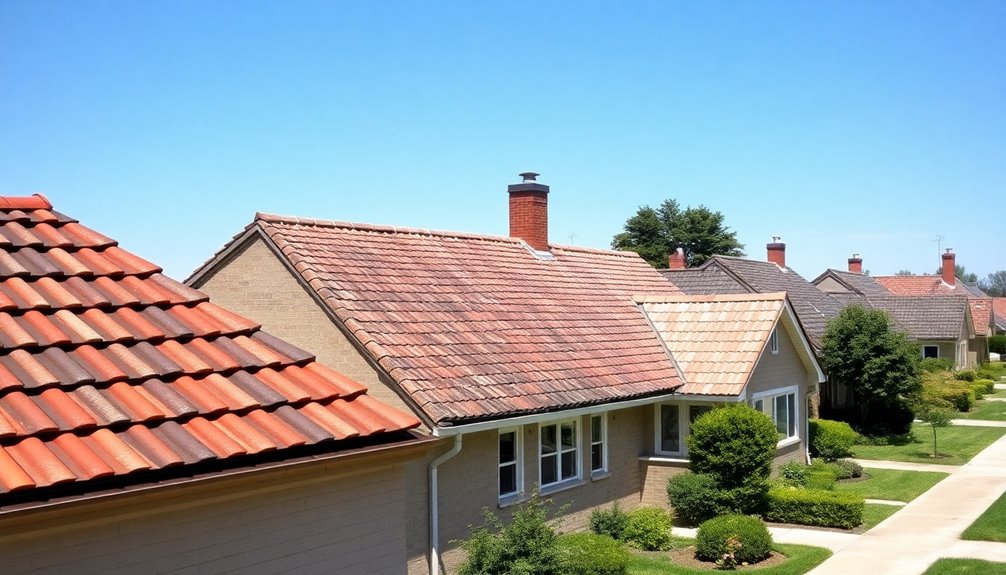
During the 1950s, homeowners embraced a variety of roofing materials that combined style with functionality. Asphalt shingles became the dominant choice, thanks to their affordability and ease of installation.
In regions influenced by Mediterranean architectural styles, clay tile offered durability and a unique aesthetic. Meanwhile, metal roofs made from aluminum and steel gained popularity for their longevity and sleek appearance, suitable for both residential and commercial buildings.
Cedar shakes were favored for their natural look and excellent insulation, often gracing higher-end homes. Flat roofs, commonly constructed with built-up roofing (BUR) systems, were prevalent in modernist architecture, reflecting the minimalist design trends of the era.
Each choice showcased the diverse preferences of homeowners during this vibrant decade.
Innovations in Roofing Technology

As you explore the innovations in roofing technology during the 1950s, you'll notice significant advancements in material production and installation techniques.
These improvements not only made roofs more durable but also easier to install, transforming the way builders approached roofing projects.
You'll also see the beginnings of smart roofing integrations that set the stage for future developments in energy efficiency and design.
Advancements in Material Production
The 1950s marked a significant turning point in roofing technology, with several key advancements transforming material production. Innovations in asphalt shingle manufacturing made them more durable and affordable, solidifying their popularity in residential roofing.
You'd find that fiberglass reinforced materials improved fire resistance and longevity, offering a modern alternative to traditional materials like felt.
Additionally, metal roofing systems, including aluminum and steel, emerged, showcasing remarkable durability and design flexibility for diverse architectural designs.
Advances in manufacturing techniques also led to enhanced waterproofing solutions, boosting the overall performance and lifespan of roofing materials.
These improvements not only shaped the roofs of the 1950s but also set the stage for future innovations in roofing technology. Furthermore, advancements in thermal energy transfer have influenced the integration of energy-efficient roofing systems that contribute to sustainable building practices.
Enhanced Installation Techniques
While many roofing advancements focused on materials, the 1950s also saw a significant evolution in installation techniques that enhanced overall roof performance.
The introduction of built-up roofing (BUR) systems allowed for multi-layered applications that improved stability and longevity for flat roofs. Efficient heat application techniques contributed to better adhesion of tar and gravel, boosting durability in commercial settings.
Chemical bonding methods simplified the installation of rubber membranes like EPDM, which gained popularity for their resilience. Furthermore, the shift to fiberglass in roofing materials replaced traditional felt, enhancing performance.
Fastener systems emerged, improving weather resistance and ensuring watertight seals, essential for maintaining the integrity of roof systems across various climates.
Smart Roofing Integrations
With advancements in installation techniques setting the stage, roofing technology has taken a remarkable leap forward in recent years.
Smart roofing systems now offer real-time monitoring of roof conditions, allowing you to stay ahead of maintenance needs and avoid costly repairs. The integration of solar panels into these roofs not only harnesses renewable energy but also enhances your home's aesthetic appeal.
Plus, advanced insulation technologies, like reflective roofing materials, boost energy efficiency by minimizing heat absorption and cutting cooling costs.
Building Information Modeling (BIM) improves planning accuracy and fosters collaboration among contractors, while drones revolutionize roof inspections, providing quick assessments of hard-to-reach areas. Furthermore, the use of predictive analytics in roofing can help anticipate potential issues before they occur.
Together, these innovations create smarter, more efficient roofing solutions for modern homeowners.
Regional Variations in Roofing Styles
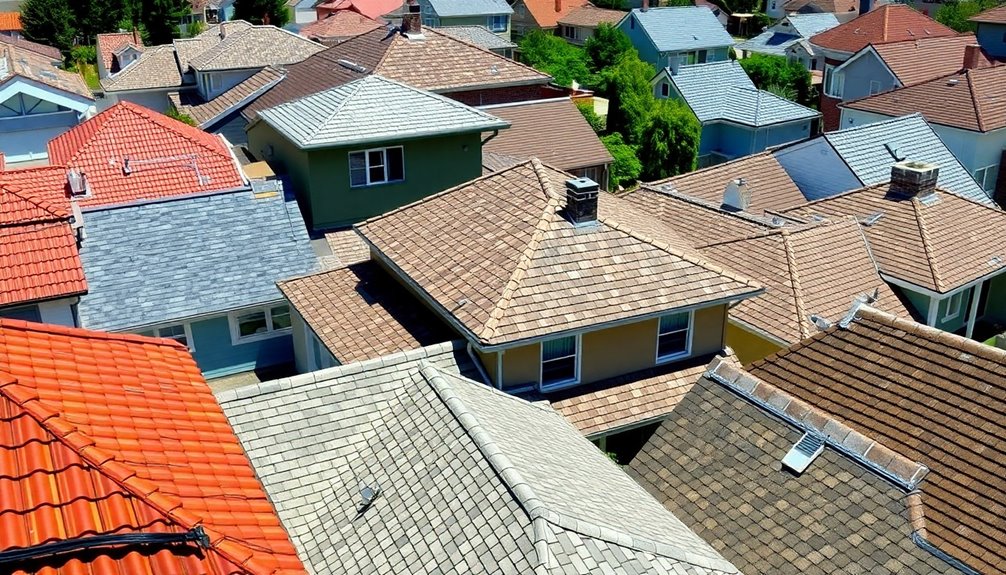
When you look at roofing styles from the 1950s, you'll notice how geography shaped design choices across the country.
Different regions favored unique materials and architectural trends that fit their climates and resources. From clay tiles in the Southwest to metal roofs in Florida, each area showcased its distinct preferences in roofing.
Geographic Influences on Design
In the 1950s, roofing styles across the United States reflected a fascinating blend of regional characteristics shaped by climate, culture, and architectural trends. You'd notice how geographic influences dictated the choice of materials.
| Region | Popular Roofing Styles |
|---|---|
| Urban Areas | Flat roofs |
| Southwest | Clay tiles |
| Northeast | Slate tiles |
| Midwest | Asphalt shingles |
| Coastal Regions | Metal roofing |
These choices weren't random; they stemmed from the need for durability and aesthetics. For instance, clay tiles thrived in arid climates, while slate tiles adorned historical estates. Meanwhile, asphalt shingles became a staple in the Midwest, reflecting the post-war housing boom, and metal roofs provided resilience in coastal areas.
Architectural Trends by Region
Regional roofing styles in the 1950s not only showcased local materials but also embraced architectural trends that defined communities.
In urban areas, particularly in the Midwest and West, flat roofs became popular, reflecting modernist design ideals.
Coastal regions, influenced by Spanish Colonial architecture, leaned toward clay tiles and metal roofs for their durability and aesthetic charm.
In the Northeast, residential homes often featured asphalt shingles and slate roofs, prized for their longevity and traditional appeal.
Meanwhile, the Midwest favored a mix of gable and hip roofs topped with asphalt shingles to efficiently shed snow and rain.
Southern states, embracing the practical benefits of metal roofs, often used them in agricultural buildings to withstand extreme heat and heavy rains.
Material Choices Across Areas
Though the 1950s saw a rising popularity of asphalt shingles nationwide, material choices for roofing varied considerably based on geographic and climatic conditions.
In warmer regions, clay tiles became a staple, reflecting the influence of Spanish Colonial architecture.
Meanwhile, the Northeastern U.S. favored slate roofing for its durability and elegance, often seen as a symbol of affluence.
In the Pacific Northwest, wood shingles, especially Western red cedar, were popular due to their natural look and insulating properties.
Conversely, in industrial areas, metal roofing gained traction for commercial buildings, prized for its longevity and ability to withstand harsh weather.
These diverse roof materials not only defined aesthetics but also suited specific environmental needs.
Maintenance Practices for 1950s Roofs
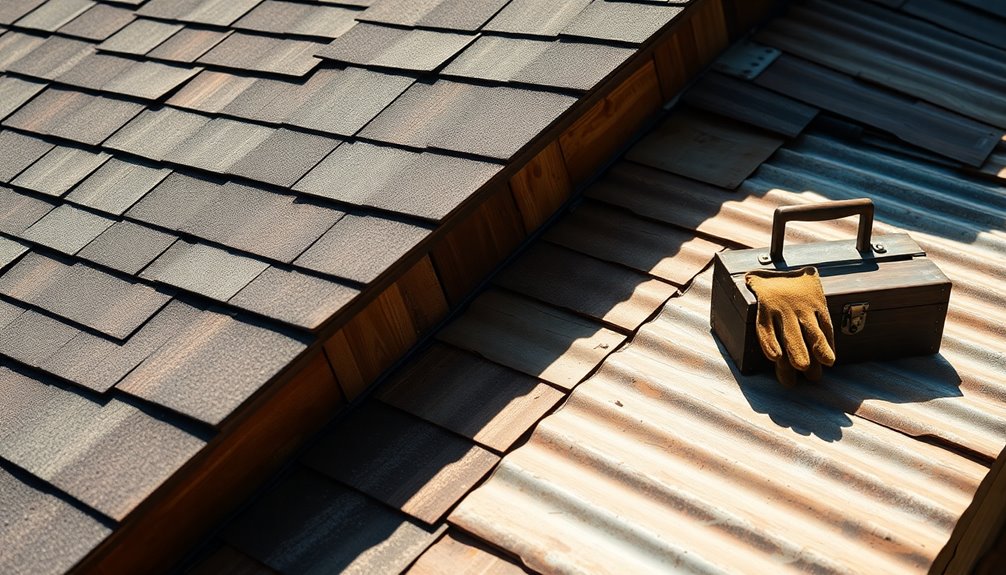
To keep roofs from the 1950s in good shape, regular maintenance is essential. Conduct inspections at least twice a year, focusing on asphalt shingles for signs of wear like cracking or granule loss.
For flat roofs, guarantee proper drainage by clearing debris from gutters and downspouts to prevent leaks. Check the flashing, as it can corrode over time; replace any damaged sections to avoid water infiltration.
Don't overlook ventilation—insufficient airflow can deteriorate materials and cause ice dams in colder climates. Installing ridge or soffit vents can help.
Finally, if you have gravel and tar roofs from industrial applications, regular cleaning will maintain drainage efficiency and prevent debris buildup that obstructs water flow.
Impact on Mid-Century Architecture
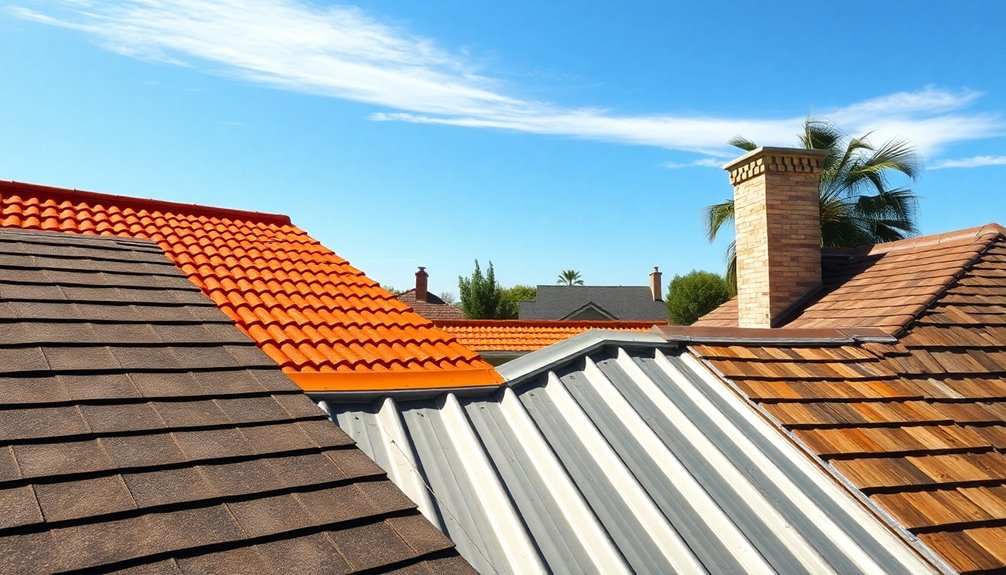
As mid-century architecture emerged, roofs played a crucial role in defining the style and functionality of homes from the 1950s.
You'll notice that asphalt shingles dominated residential roofing, celebrated for their affordability and variety, allowing personalization. Low-pitched roofs became a defining characteristic of mid-century homes, enhancing the clean lines that were essential to modern aesthetics.
Large overhangs not only contributed to architectural style but provided shade and rain protection, improving livability. Metal roofing gained traction for its durability and sleek look, aligning with the era's innovative materials.
Meanwhile, clay and concrete tiles introduced distinctive textures and colors, reflecting a fascination with blending indoor and outdoor spaces, further enriching the architectural landscape of the time.
Frequently Asked Questions
What Were Roofs Made of in the 1950S?
Roofs in the 1950s featured a mix of materials that catered to different needs and styles.
You'd find asphalt shingles dominating due to their affordability and ease of installation.
Metal roofing gained traction for its durability, while wood shingles still appealed to many for their natural look.
In warmer climates, clay and concrete tiles offered both style and resilience.
Flat roofs often used built-up roofing systems for stability and weather protection.
Each choice reflected unique preferences.
What Years Was Asbestos Used in Roofing?
Asbestos was widely used in roofing from the early 1900s until the late 1970s.
You'll find it peaked in popularity during the 1940s and 1950s, where it was favored for its fire resistance and durability.
If you're considering renovations on older homes, be mindful that many might still have asbestos-containing materials.
Always guarantee you get a professional assessment, as damaged asbestos can pose serious health risks.
Stay safe and informed!
What Are Old Roofs Made Of?
When you think about old roofs, you'll find a mix of materials. Many were made from wood shingles or shakes, offering natural insulation and charm.
Asphalt shingles became popular for their cost and easy installation. Metal roofing, like galvanized steel, provided durability, while clay tiles added a unique architectural flair, especially in warmer regions.
Roll roofing was also common, particularly for garages, due to its affordability and simplicity.
What Were Roofs Made of Before Shingles?
Before shingles became the norm, roofs were made of various materials that offered different benefits.
You'd find wood shakes and shingles providing a natural look and insulation. In warmer climates, clay tiles were popular for their durability.
If you lived in the Northeast, slate might've been your choice due to its longevity. Metal roofing was also used in commercial buildings, while built-up roofing systems catered to low-slope applications.
Each material had its unique advantages!
Conclusion
In exploring the roofing materials of the 1950s, you might think those choices were outdated or unreliable. Ironically, many of those retro roofs have stood the test of time, showcasing durability that modern options sometimes lack. So, as you admire the sleek lines and vibrant colors of mid-century architecture, remember that beneath it all lies a legacy of innovation that still influences roofing today. Who knew that yesterday's trends could teach us so much about today's choices?
